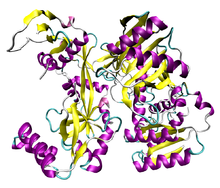
Back Argonaut (protein) Czech Argonautenproteine German Argonaute (protéine) French Argonauta (proteína) Galician Argonaute Italian アルゴノート (タンパク質) Japanese Argonaute Russian Аргонавт (білок) Ukrainian Argonaute Chinese
The Argonaute protein family, first discovered for its evolutionarily conserved stem cell function,[1] plays a central role in RNA silencing processes as essential components of the RNA-induced silencing complex (RISC). RISC is responsible for the gene silencing phenomenon known as RNA interference (RNAi).[2] Argonaute proteins bind different classes of small non-coding RNAs, including microRNAs (miRNAs), small interfering RNAs (siRNAs) and Piwi-interacting RNAs (piRNAs). Small RNAs guide Argonaute proteins to their specific targets through sequence complementarity (base pairing), which then leads to mRNA cleavage, translation inhibition, and/or the initiation of mRNA decay.[3]
The name of this protein family is derived from a mutant phenotype resulting from mutation of AGO1 in Arabidopsis thaliana, which was likened by Bohmert et al. to the appearance of the pelagic octopus Argonauta argo.[4]
| Argonaute Piwi domain | |||||||||
|---|---|---|---|---|---|---|---|---|---|
 An argonaute protein from Pyrococcus furiosus. PDB 1U04. PIWI domain is on the right, PAZ domain to the left. | |||||||||
| Identifiers | |||||||||
| Symbol | Piwi | ||||||||
| Pfam | PF02171 | ||||||||
| InterPro | IPR003165 | ||||||||
| PROSITE | PS50822 | ||||||||
| CDD | cd02826 | ||||||||
| |||||||||
| Argonaute Paz domain | |||||||||
|---|---|---|---|---|---|---|---|---|---|
| Identifiers | |||||||||
| Symbol | Paz | ||||||||
| Pfam | PF12212 | ||||||||
| InterPro | IPR021103 | ||||||||
| SCOP2 | b.34.14.1 / SCOPe / SUPFAM | ||||||||
| |||||||||


- ^ Cox DN, Chao A, Baker J, Chang L, Qiao D, Lin H (December 1998). "A novel class of evolutionarily conserved genes defined by piwi are essential for stem cell self-renewal". Genes & Development. 12 (23): 3715–3727. doi:10.1101/gad.12.23.3715. PMC 317255. PMID 9851978.
- ^ Mauro M, Berretta M, Palermo G, Cavalieri V, La Rocca G (June 2022). "The multiplicity of Argonaute complexes in mammalian cells". J Pharmacol Exp Ther. 384 (1): 1–9. doi:10.1124/jpet.122.001158. PMC 9827513. PMID 35667689.
- ^ Jonas S, Izaurralde E (July 2015). "Towards a molecular understanding of microRNA-mediated gene silencing". Nature Reviews. Genetics. 16 (7): 421–433. doi:10.1038/nrg3965. PMID 26077373. S2CID 24892348.
- ^ Bohmert K, Camus I, Bellini C, Bouchez D, Caboche M, Benning C (January 1998). "AGO1 defines a novel locus of Arabidopsis controlling leaf development". The EMBO Journal. 17 (1): 170–180. doi:10.1093/emboj/17.1.170. PMC 1170368. PMID 9427751.